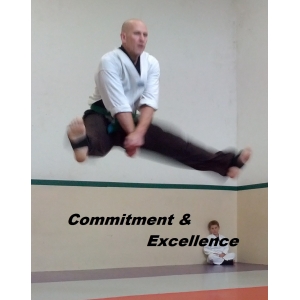Water aerobics would make more sense; or maybe even yoga, so why choose one of the “hardest” of hard martial arts, known for its powerful, and sometimes aerial, kicks? The short answer is that it was accidental. My 11-year-old son wanted to give it a try, so I brought him in to Koryo Do School of Tae Kwon Do for a try out class because it was the closest to our house. I took a seat, intending to relax while I watched my son work up a seat. I only got to sit for about five minutes before being invited to join in and learn some simple self-defense moves. I was hooked. Unfortunately, my son discontinued coming after about a year, but I continued. Almost four years and about 1500 hours of training later I’m about to test for black belt.
What kept me coming back was a combination of things. Initially it was for the workout and having fun with the other (usually much younger) students. Later it was for the physical and mental challenge, and the fact that I realized that I was actually making progress. My kicks, which had started at about knee high, were beginning to approach waist high. The sky was the limit!
Taking on a challenge like tae kwon do after the age of 50 may seem daunting, but with a little common sense and good instructors you will find yourself accomplishing things you might never have thought possible at your age.
These are some of the lessons I have learned, sometimes the hard way, during my training.
Physical flexibility
There’s no way around it. You are not as flexible as you once were. If you are athletic and in reasonably good shape, as I was when I first started, you may not be aware of how much your flexibility has changed over the years until you really start pushing the limits, and tae kwon do will push those limits. Good news, though. You will be surprised at how much your flexibility can improve with stretching and patience.
Trust your instructors, but also trust your body
Many of the students in your school are young and can jump right into stretching without warming up. You can’t. Before stretching make sure you have done some activity that has warmed you up enough that you are sweating a little. Your instructors will teach you effective stretches, but it’s up to you to know what your body is trying to tell you. Go into your stretches slowly and increase slowly. Also, come out of your stretches slowly. Don’t push a stretch if it becomes too painful, you might cause muscle, tendon, or ligament damage. Increasing flexibility takes time. Just push a little more each time and you’ll see results. Some of my kicks that started off at knee or waist height are now head high. Some of my other kicks are not, and they never will be. I’m OK with that.
You will see students and instructors performing impressive jumping and spinning kicks. Eventually, with practice, you will also be able to do some of these kicks, but try to accept that there may be some kicks that just aren’t possible for you as an older student. Don’t fall into the trap of trying to compete with younger students. It will end badly.
What you lack in flexibility, you will more than make up for in wisdom, patience, and persistence.
Stamina
Stamina will come with time. Push yourself, but know when you are pushing too hard. Being tired or exhausted is good, passing out is bad. Your instructors want you to progress, but not at the expense of your health, so speak up if you are feeling dizzy or nauseous. As an older student you should pay special attention to nutrition, hydration, and trying to make sure you get enough sleep. Bring your own water, or a sports drink if you wish, to every class. Make sure you hydrate sufficiently before and after class. Your stamina will increase as you gain cardiovascular and muscular strength, and also as you gain proficiency. When you are proficient at a form, kick, or combination you will relax and expend less energy.
Sleep is more important than you might think. We process new information and build neural pathways at night. You will be learning increasingly difficult forms and combinations that require internalization, and a full sleep cycle is essential to that process. Learning a martial art is like learning a new language.
Mental flexibility
This is the big one. As we get older our neural pathways become less plastic. We have been doing things the same way for forty or fifty years and it’s hard for us to change. This has been my greatest challenge in my practice of tae kwon do. I have always been an athlete. Running marathons, playing high school and college football, lifting weights, cycling, wind-surfing, and surfing. I always thought of my physical strength as an asset, which it can be at times, but as my master has told me over and over again, “your strength is your weakness.” What he means is that I’ve relied on my strength for so long it’s hard to let it go. In tae kwon do your strength comes from technique, not muscle. I’m still working on it, but my advice to you is to relax and let your body take over. Don’t overthink. Trust that your body, with training, will know what to do. Also, try not to get discouraged if you can’t do it “perfectly” the first time. The “side kick” is one of the first kicks you will learn in tae kwon do, but masters will tell you that this kick can take decades to perfect.
Family and responsibilities
As an adult you have a lot of responsibilities. Family, work, etc. You may not be able to come to class every day, but it’s important to make a schedule and stick with it. Know that every week you will be going to classes during specific hours and on specific days. If you leave it to chance you will always be able to come up with an excuse not to go. Newly learned skills disappear quickly if not practiced on a regular basis. Also, your family will appreciate knowing exactly when you will be at home or at tae kwon do class. The best scenario is to take classes as a family, if possible. Always be conscious that your time at class is time away from them, and if you need to miss a class every now and then for family time, so be it.
Goals
Tae kwon do, like many martial arts, uses a belt system to mark progress and skill level. Training for and passing belt tests are great goals to work toward. Working toward the next test helps keep you focused. As older, successful, adults we are often very goal-oriented anyway. If you eventually earn a black belt, don’t think of it as a “diploma.” A black belt simply indicates that you have gained the basic foundational knowledge necessary to continue growing as a martial artist. I look at tae kwon do as my “retirement health plan” that will, I hope, help keep me fit, mobile, and engaged into my nineties and, maybe, beyond. I’ve met masters from various martial arts who are in their eighties and can put most twenty-year-olds to shame. Your black belt will simply be another sign post that you pass on your continuing journey in tae kwon do.

